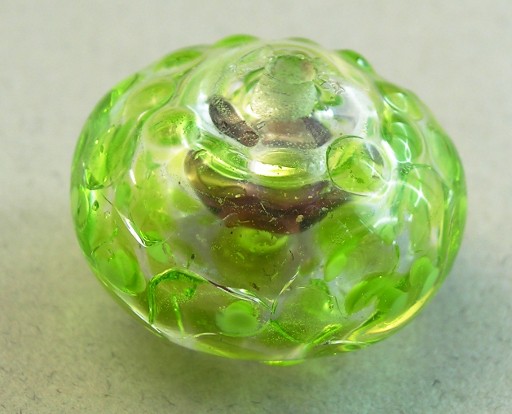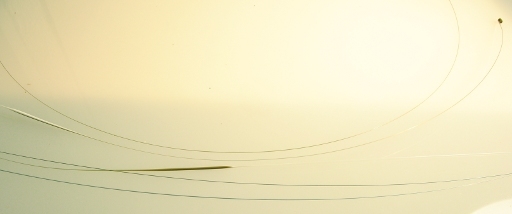
This demo bead was made during Winter Wonders, and, alas, someone obviously mixed a rod of BE with the effetre: you can see the stress cracks following the perimeter of the dots. I initially assumed the green was the culprit, but I suppose the CLC might be the guilty party. In any event, the results are the same: a cracked, useless bead.
Do not mix Effetre and Bullseye. That is all[1]

Thread tests are one way to ID a rod. As you see, effetre white and (strictly speaking, vetrofond) black are not perfectly compatible (bottom 2), but effetre white and BE very dark brown are really not compatible (top 3). Not the lumps where the brown pulled loose from the white, and also how much more the thread tests curled (middle).
photos 20090208, 0213; file created 13feb09.
[1]Except, of course, it isn't. Now that the manufacturers are moving into each other's territories, so to speak, it's getting much harder to just look at a rod and know what kind of glass it is. For this reason I'm fanatical about marking my BE, and if I have the slightest doubts, I test, as shown. Or throw the mystery glass out. This kind of grief is just so not worth it. —Thread tests are quite easy to do: put a dab of contrasting color of a known coe on the tip of a rod, melt till the end balls, half and half; grasp and pull. A properly made test will consist of a thread round in cross-section that is half one color and half the other, and higher coe glass will contract more, causing the thread to deflect (bend). The greater the curl, the lower the compatibility. As the test shows, even in "compatible" effetre, there's still some range. If you want to get fanatic, you can measure the diameter of the thread, its length, and deflection, and plug it into a formula to calculate the difference—the wizard wrote a cute little perl script that I used to do just that, back when I was testing PIG and check glass...
Unless otherwise noted, text, image and objects depicted therein copyright 1996--present sylvus tarn.
Sylvus Tarn